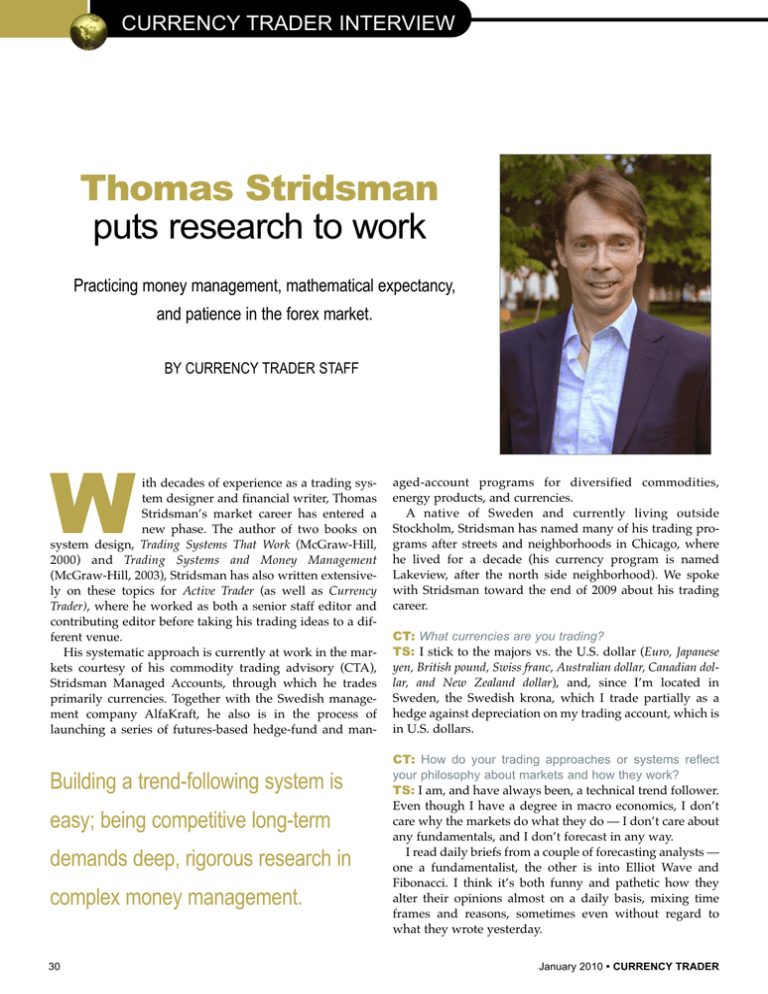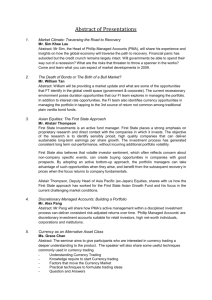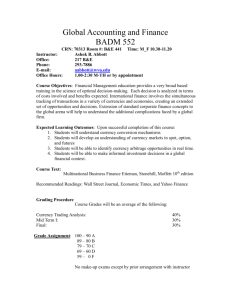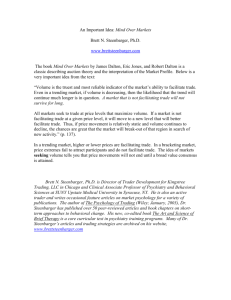W Thomas Stridsman puts research to work CURRENCY TRADER INTERVIEW
advertisement

CURRENCY TRADER INTERVIEW Thomas Stridsman puts research to work Practicing money management, mathematical expectancy, and patience in the forex market. BY CURRENCY TRADER STAFF W ith decades of experience as a trading system designer and financial writer, Thomas Stridsman’s market career has entered a new phase. The author of two books on system design, Trading Systems That Work (McGraw-Hill, 2000) and Trading Systems and Money Management (McGraw-Hill, 2003), Stridsman has also written extensively on these topics for Active Trader (as well as Currency Trader), where he worked as both a senior staff editor and contributing editor before taking his trading ideas to a different venue. His systematic approach is currently at work in the markets courtesy of his commodity trading advisory (CTA), Stridsman Managed Accounts, through which he trades primarily currencies. Together with the Swedish management company AlfaKraft, he also is in the process of launching a series of futures-based hedge-fund and man- Building a trend-following system is easy; being competitive long-term demands deep, rigorous research in complex money management. 30 aged-account programs for diversified commodities, energy products, and currencies. A native of Sweden and currently living outside Stockholm, Stridsman has named many of his trading programs after streets and neighborhoods in Chicago, where he lived for a decade (his currency program is named Lakeview, after the north side neighborhood). We spoke with Stridsman toward the end of 2009 about his trading career. CT: What currencies are you trading? TS: I stick to the majors vs. the U.S. dollar (Euro, Japanese yen, British pound, Swiss franc, Australian dollar, Canadian dollar, and New Zealand dollar), and, since I’m located in Sweden, the Swedish krona, which I trade partially as a hedge against depreciation on my trading account, which is in U.S. dollars. CT: How do your trading approaches or systems reflect your philosophy about markets and how they work? TS: I am, and have always been, a technical trend follower. Even though I have a degree in macro economics, I don’t care why the markets do what they do — I don’t care about any fundamentals, and I don’t forecast in any way. I read daily briefs from a couple of forecasting analysts — one a fundamentalist, the other is into Elliot Wave and Fibonacci. I think it’s both funny and pathetic how they alter their opinions almost on a daily basis, mixing time frames and reasons, sometimes even without regard to what they wrote yesterday. January 2010 • CURRENCY TRADER I read them, anyway, so I can keep up my end of a market discussion, as I have noticed people almost get offended if they ask me about the markets and I give them the true answer, which would be, “I have no clue.” So in short, my philosophy is to just follow the damn trends. Trading one sector only, you have nothing working for you when all the [markets] in the sector suddenly correlate against you, so I had to add a correlation filter to my otherwise very standard breakout system. continued on p. 32 CT: What kind of trading approaches are you using? TS: First of all, I am 100-percent systematic and I only work with daily data and breakout-type patterns based on 15- to 25-day lookback periods. The few times in my life I’ve tried to deviate from the systematic approach, I have failed. I have a 100-percent track record in that regard. Sure, being a systematic trend follower also induces some pain from time to time, but overall results move slowly in the right direction. Trend followers need to learn to sit on their hands from time to time, and other times endure the pain from what seems like a never-ending string of whipsaw trades. That just comes with the style. CT: Is the system you’re trading designed specifically for currencies, or is it the same system, or type of system, you’ve designed for other markets? TS: I’ve been trading currencies for about two years now. When I worked as a researcher and writer prior to trading currencies, I mostly constructed systems for multi-sector portfolios. What surprised me, and what I had to learn the hard way, was how vulnerable you are to correlations when you trade only one sector. I took a huge hit early on — in the spring of 2008 — because of this, but I adapted well when I recognized the root problem. The systems I’m using for my currency trading are adaptations of multi-sector systems, mostly because of the correlation issue. I recently started to trade a larger commodity portfolio as well, with systems very similar to my currency systems. CURRENCY TRADER • January 2010 31 CURRENCY TRADER INTERVIEW CT: Are you trading more than one system? Are your systems always in the market? TS: I’m trading two systems, and both are capable of staying out of the market completely from time to time. In fact, that’s exactly what’s going on with one of the systems right now (late December). It has no trades in any market at the moment. This is because of the correlation issues I just mentioned. CT: What about money management? What’s your approach, and what role does that contribute to your performance relative to the entry and exit signals themselves? TS: Those who have read my books know that I believe money management is much more important than the systems themselves, as long as the systems have a positive mathematical expectancy. The money management algorithm should do the income-generating work. The signal-generating systems should just feed that algorithm with a flow of money, in and out, to work on. That’s the way it should be. In reality, I, too am trapped by real-life constraints, with an account too small to make the most of what I just mentioned. So, in my current situation, the systems are more important, relatively speaking, than I would like them to be. With an account three to five times larger than my current funds, I would be able to start correcting this relationship. CT: Has there been a big difference between your system performance in testing and real-market performance? Have there been any “surprises”? TS: Not really, other than the correlation issues I mentioned. Living in Europe and trying to work European day-time hours, I’ve noticed the most unanticipated, costly part of my trading is when I need to roll commodity contracts in very thin markets. But because trading forex doesn’t have that issue, the results have been mostly as expected. Sometimes there can be discrepancies in the data, because there is no single correct data feed in forex trading, 32 January 2010 • CURRENCY TRADER but profits and losses work both ways, and I have a few simple rules for dealing with that. CT: What unique ideas or tactics do you think you use? TS: In terms of the currency trading, I don’t think I do anything unique and different from other trend-following currency traders. That said, as a trend follower, you need to be more patient than most people. Trend following can be really dull, so if you like action-packed days, trend following is not for you. I guess my main tactic is to be patient. CT: Okay, so how do you “compete,” so to speak, with other trend-followers? TS: That’s a good question; let me answer it in two parts. First, [I compete] simply by not going broke. I mentioned how I took a big hit early on because of misjudging how the markets could correlate against me. Well, many trend-following currency traders did the same without learning the lesson from it — they continued to trade too big and subsequently went out of business with 60- to 70-percent losses, among them a rather famous outfit that was frequently a top-ranked CTA in the currency sector. Second, it’s a slow process, during which you have to make any prospective investors aware of the fact you’re capable of producing a slightly better risk-adjusted return than most other trend followers. Unfortunately, this process can take several years before it becomes really obvious, during which time you just have to refrain from trying to swing for the fences. It all goes back to what you asked about money management. Building a trend-following system is easy; being competitive long-term demands deep, rigorous research in complex money management. CT: Do you have any program targets — risk-adjusted reward, etc.? TS: No goals or targets of any kind for the actual trades — it’s just a matter of letting the markets do what they do, and following them with a trailing stop. Estimated long-term performance targets would be around 15 percent per year, preferably with a Sharpe ratio around 0.7 or so. CT: What was it like dealing with the market disruption during the financial crisis last year and earlier this year? TS: The last five to six months of 2009 were very dull. Following a strong May and June, a bunch of whipsaw trades put many currency and commodity trend followers in drawdowns, and I’m no exception. At the end of October I was down 1.8 percent for the year; I think Barclay’s currency trader’s index was up less than 1 percent. In 2008, I was up 5 percent, after a strong comeback in the second half of the year, following the correlation-related drawdown I mentioned earlier. From the drawdown botCURRENCY TRADER • January 2009 I need to internalize only two facts about a system: that I understand and accept the logic behind it, and that it has a positive mathematical expectancy. tom I’m up 42 percent over the past 18 months. So, from fall 2008 to spring 2009 — which most people probably think of as the most negative period, because that’s when the stock market tanked the most — I was doing really well, thanks first to a couple of good long-dollar trades, and then, when the markets reversed, a couple of short-dollar trades. On top of that I had a natural long-dollar position relative the Swedish krona because my account equity is in U.S. dollars. In fact, the results of many trend-following currency and commodity traders over this period are a good reminder that there are plenty of opportunities, even in what seems like the darkest times. You just have to look a bit further than news headlines. CT: What’s the most important thing to consider as a trader? TS: To me, it’s important to understand that as a trend follower, you have to learn to let both the good and bad times slide, and try to remain zen about the whole thing. Since it’s supposed to be a statistics game, including both good and bad outliers, I think it would be devastating to pick a few good trades and try to model your systems around them. That would only result in a system too curve-fitted to those instances, which would be terrible to trade forward in real time; likewise if you try to build a system avoiding a few large losers. I actually work quite hard at avoiding knowing too much about the nitty-gritty about my systems, during both real trading and research. Regarding the system itself, I need to internalize only two facts: that I understand and accept the logic behind it, and that it has a positive mathematical expectancy. On a trade-by-trade basis — regardless of the actual outcome of the trade — all I need to ask myself is, did I do what I was supposed to do? Probably the best setup you can have as a trend follower is a string of losing trades in the same market in the same direction. You just need to place the next trade the same way. Right now, for example, I’m making some money in the yen, but other than that I have two to three losers in a row in everything else. But I trust the mathematical expectancy will work in my favor in the end. 33





